#Orphism
Text
The Petelia Tablet, Greek, c.300-200 BCE: this totenpass (a "passport for the dead") was meant to be buried in a human grave; it bears an inscription that tells the dead person exactly where to go and what to say after crossing into the Greek Underworld
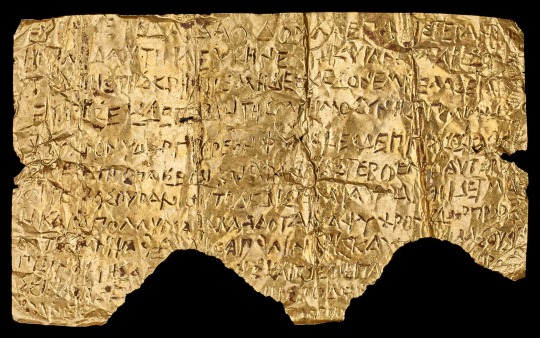
Made from a sheet of gold foil, this tablet measures just 4.5cm (a little over 1.5 inches) in length, and although it was found inside a pendant case in Petelia, Italy, it's believed to have originated in ancient Greece. It was meant to aid the dead in their journey through the Underworld -- providing them with specific instructions, conferring special privileges, and granting them access to the most coveted realms within the afterlife.
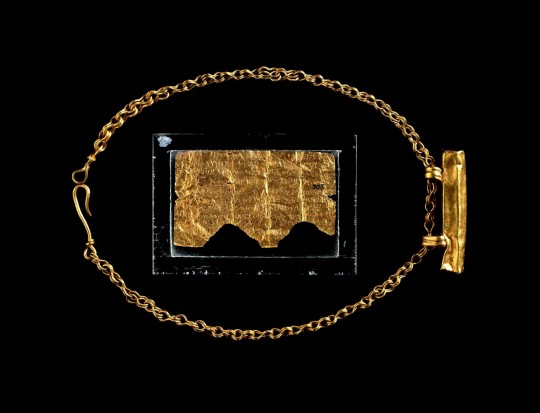
The Petelia tablet, displayed with the pendant case in which it was discovered
The tablet itself dates back to about 300-200 BCE, while the pendant case/chain that accompanies it was likely made about 400 years later, during the Roman era. It's believed that the tablet was originally buried with the dead, and that an unknown individual later removed it from the burial site and stuffed it into the pendant case. Unfortunately, in order to make it fit, they simply rolled it up and then snipped off the tip of the tablet. The final lines of the inscription were destroyed in the process.

The inverse side of the Petelia tablet
These textual amulets/lamellae are often referred to as totenpässe ("passports for the dead"). They were used as roadmaps to help guide the dead through the Underworld, but they also served as indicators of the elite/divine status of certain individuals, ultimately providing them with the means to obtain an elevated position in the afterlife.
The Petelia tablet is incised with an inscription in ancient Greek, and the translated inscription reads:
You will find a spring on your left in Hades’ halls, and by it the cypress with its luminous sheen.
Do not go near this spring or drink its water. You will find another, cold water flowing from Memory’s lake; its guardians stand before it.
Say: "I am a child of Earth and starry Heaven, but descended from Heaven; you yourselves know this. I am parched with thirst and dying: quickly, give me the cool water flowing from Memory’s lake."
And they will give you water from the sacred spring, and then you will join the heroes at their rites.
This is [the ... of memory]: [on the point of death] ... write this ... the darkness folding [you] within it.
The final section was damaged when the tablet was shoved into the pendant case; sadly, that part of the inscription does not appear on any of the other totenpässe that are known to exist, so the meaning of those lines remains a mystery (no pun intended).
Lamellae that are inscribed with this motif are very rare. They're known as "Orphic lamellae" or simply "Orphic tablets." As the name suggests, these inscriptions are traditionally attributed to an Orphic-Bacchic mystery cult.
The inscriptions vary, but they generally contain similar references to a cypress tree, one spring that must be avoided, another spring known as the "Lake of Memory," the sensation of thirst, and a conversation with a guardian (or another entity within the Underworld, such as the goddess Persephone) in which the dead must present themselves as initiates or divine individuals in order to be granted permission to drink from the Lake of Memory. They are thereby able to obtain privileges that are reserved only for the elite.
Though the specifics of this reward are often vague, it may have been viewed as a way to gain access to the Elysian Fields (the ancient Greek version of paradise) or as a way to participate in sacred rites; some totenpässe suggest that it may have allowed the soul to break free from the eternal cycle of reincarnation. Regardless, the overall objective was likely the same: to obtain a special status and acquire privileges that were inaccessible to most of the souls in the Underworld.
Sources & More Info:
Altlas Obscura: The Ancient Greeks Created Golden Passports to Paradise
The Museum of Cycladic Art: The Bacchic-Orphic Underworld
Bryn Mawr College: Festivals in the Afterlife: a new reading of the Petelia tablet
The Getty Museum: Underworld (imagining the afterlife)
The British Museum: Petelia tablet (with pendant case; chain)
#archaeology#history#anthropology#ancient greece#ancient history#greek mythology#Petelia tablet#Greek mysteries#orphic mysteries#orphism#greek underworld#hades#persephone#anthropology of death#religon#afterlife#tw death#classical antiquity#classical archaeology#ticket to paradise#whoever damaged this#probably#got#a#ticket#to tartarus#instead
2K notes
·
View notes
Text


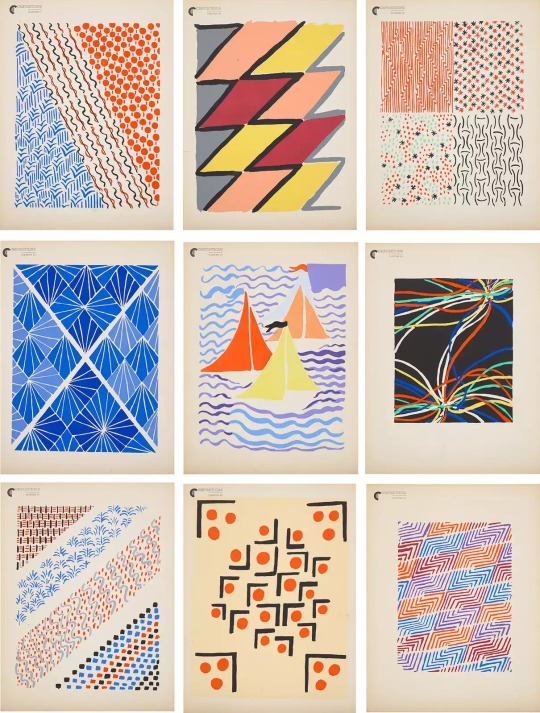

Sonia Delaunay
Compositions, Couleurs, Idées, 36 plates
1930
#modern art#abstract#sonia delaunay#delaunay#compositions#textile art#textiles#abstract art#ideas#colors#textile#orphism#french artist#french legion of honor#geometric abstraction#Académie de La Palette#robert delaunay
1K notes
·
View notes
Text

Polychrome terracotta sculpture of the god Dionysos, holding an egg and a rooster. The unusual attributes may hint at a connection to Orphism, which held that the first deity, Phanes or Protogonos ("First-Born"), was hatched from a cosmic egg. Adherents of Orphism saw humankind as the descendants of Dionysos (under the name "Zagreus"), created when the Titans devoured the young Zagreus and were then struck by Zeus' thunderbolt. Artist unknown; created in Tanagra, Boeotia (an important center of terracotta production) ca. 350 BCE. Now in the British Museum.
#classics#tagamemnon#Ancient Greece#Greek religion#Ancient Greek religion#Hellenic polytheism#Dionysus#Dionysos#Orphism#art#art history#ancient art#Greek art#Ancient Greek art#Classical Greece#Classical Greek art#Boeotia#Boeotian art#sculpture#terracotta#British Museum
516 notes
·
View notes
Text
From Hermes to Virgin Mary

*Mixed Dionysus myth from the Orphism.
#Orphism#dyonisus#jesus christ#virgin mary#ancient greek gods#ancient greek myth#ancient greek mythology#greek myth#greek myth art#mercury#bacchus#zagreus#jesus
286 notes
·
View notes
Text

My take on the Olympians.
Clockwise from the top center: Zeus, Athena, Mithra (Apollo), Hephaestus, Demeter, Poseidon, Hera, Ares, Anahita (Artemis), Hermes.
At center: Dionysus and Persephone.
Not pictured: Aphrodite (it's complicated...).
#Greek Mythology#Zoroastrianism#Zeus#Athena#Mithra#Apollo#Hephaestus#Demeter#poseidon#Ares#Anahita#Artemis#Hermes#Dionysus#Persephone#Orphism#Orphic Mysteries#oc
52 notes
·
View notes
Text

Artist ponies are so fun to draw :)
#orphism#artsies#oc stuff#mlp#her cutie mark is a music note#because orphism often strives to interpret reality similar to how you interpret music!#I also tried to use like Sonia delaunay esque circles#to mimic the pattern of a painted horse#:)#art ponies
70 notes
·
View notes
Text

Robert Delaunay (French, 1885-1941) • Political Drama • 1914 • Oil and collage on cardboard • National Gallery of Art, Washington D.C.
#art#painting#fine art#art history#robert delaunay#french artist#artwork#oil paint#collage#mixed media art#orphism#modern art#european modernism#early 20th century european art#pagan sphinx art blog#art blogs on tumblr
26 notes
·
View notes
Text

Title: Eiffel Tower
Artist: Robert Delaunay
Date: 1911
Style: Orphism
Genre: Cityscape
162 notes
·
View notes
Text

Sonia Delaunay
Prismes électriques, no. 41 (1913-1914)
34 notes
·
View notes
Photo

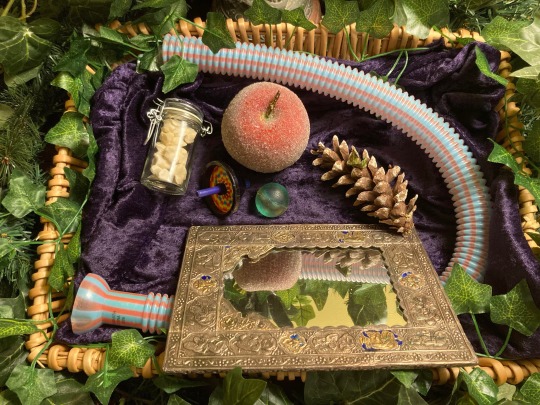
The Toys of Dionysus! From the Orphic Mystery tradition. A top, a ball, a bullhorn (the pink thing), a pinecone (or a tuft of hair), a golden apple (just pretend it’s gold), knucklebones (I got real ones!), and a mirror.
Happy Brumalia, everybody!
#dionysus#dionysos#dionysus devotion#dionysian devotion#toys of dionysus#zagreus#orphism#orphic mysteries#hellenic paganism
168 notes
·
View notes
Text
Divine Earth, mother of men and of the blessed gods, you nourish all, you give all, you bring all to fruition, you destroy all. When the season is fair, you teem with fruit and growing blossoms, O multi-formed maiden, seat of the immortal cosmos, in the pains of labor you bring forth all fruit. Eternal, revered, deep-bosomed and blessed, your joy is the sweet breath of grass, O goddess bedecked with flowers, yours is the joy of the rain, the intricate realm of the stars revolves in endless and awesome flow. O blessed goddess, may you multiply the delicious fruits, and may you and the beautiful Seasons grant me kindly favor.
- Orphic Hymn 26. To the Earth
94 notes
·
View notes
Text

Anthi Chrysanthou Defining Orphism. The Beliefs, the ›teletae‹ and the Writings, De Gruyter 2000
The complex matter of Orphism has so far been addressed by scholars through studies focusing on one of its components each time, primarily the Derveni Papyrus and the Gold Tablets while the text of the Orphic Rhapsodies has remained under-examined mostly due to its fragmentary nature and the lack of a reconstruction. This book brings all of the major components of Orphism together in one study, in this way highlighting both parallels and divergences between them, and a wide range of non-Orphic sources referring to Orphic practices, beliefs and texts. For the complete analysis of the Orphic Rhapsodies a reconstruction of the text was necessary, which is included in this book along with a commentary and translation. This work proposes a new definition of Orphism and it can constitute a whole-encompassing and concise guide for scholars and students interested in Orphism. The reconstruction of the Orphic Rhapsodies could also contribute on shifting the understanding of this work to new perspectives as it demonstrates that the Orphic Rhapsodies was a more complex text rather than a single continuous theogonic narrative as has been approached up to this date.

Anthi Chrysanthou, University of Leeds, UK
10 notes
·
View notes
Text

Sonia Delaunay
Compositions, Couleurs, Idées, No. 14
1930
80 notes
·
View notes
Text

Robert Delaunay, Champs de Mars: The Red Tower, 1911/1923, oil/canvas (Art Institute, Chicago)
25 notes
·
View notes
Text

was anyone gonna tell me that zagreus's cock and balls were worshiped by the demigod sons of hephaestus or was i supposed to find that out on his theoi page by myself
#zagreus#hades#hades supergiant#hades game#hades ii#hades 2#greek mythology#kabeiroi#orphic mysteries#greek myth#classical mythology#orphism#orphic dionysus#they should've included this in hymn to zagreus tbh
72 notes
·
View notes
Text
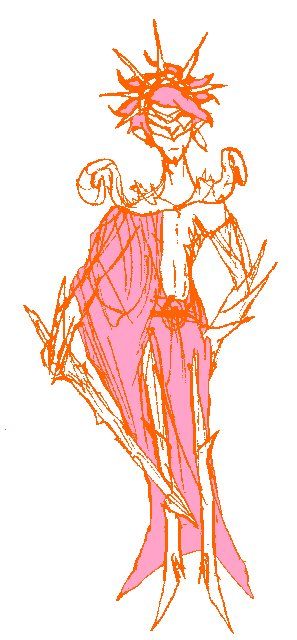

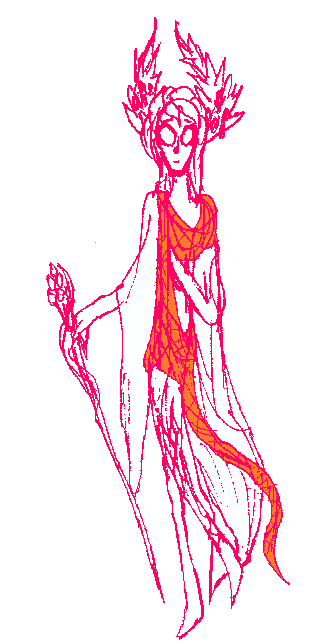
Apollo, Artemis, and Dionysus.
#Greek Mythology#Apollo#Artemis#Dionysus#Orphic Dionysus#Dionysus Zagreus#Orphism#Orphic Mysteries#Awakening of Orpheus#oc#yes these are basically designs for mithra and anahita whenever i use them in a solely greek context
23 notes
·
View notes